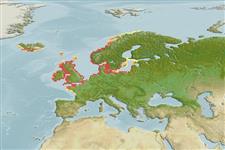Bathyporeia pilosa Lindstrom, 1855
Sand digger shrimp| Native range | All suitable habitat | Point map | Year 2050 |

|
| This map was computer-generated and has not yet been reviewed. |
| Bathyporeia pilosa AquaMaps Data sources: GBIF OBIS |
Google image |
No photo available for this species.
Classification / Names Populärnamn | synonymer | CoL | ITIS | WoRMS
Malacostraca | Amphipoda | Pontoporeiidae
Environment: milieu / climate zone / djupintervall / distribution range Ekologi
; djupintervall 1 - 5 m (Ref. 95818). Temperate
Distribution Länder | FAO områden | Ekosystem | Förekomster | Utplanteringar
Northeast Atlantic: Aland Island, Germany, Estonia and Belgium; Iberian Peninsula.
Length at first maturity / Size / Weight / Age
Könsmognad: Lm ? range ? - ? cmCommon length : 0.51 cm BL (female)
Life cycle and mating behavior Könsmognad | Reproduktion | Lek | Eggs | Fecundity | Larvae
Main reference
referenser | Koordinator | Medarbetare
Kotta, J. and H. Orav 2001 Role of benthic macroalgae in regulating macrozoobenthic assemblages in the Vainameri (north-eastern Baltic Sea). Ann. Zool. Fennici 38:163-171. (Ref. 95753)
IUCN Red List Status
(Ref. 130435: Version 2025-1)
CITES status (Ref. 108899)
CMS (Ref. 116361)
Threat to humans
Human uses
| FishSource |
Verktyg
Ytterligare information
Max. ages / sizes
Length-weight rel.
Length-length rel.
Length-frequencies
Mass conversion
Abundans
Internet-källor
BHL | BOLD Systems | CISTI | DiscoverLife | FAO(Publication : search) | Fishipedia | GenBank (genome, nucleotide) | GloBI | Gomexsi | Google Books | Google Scholar | Google | PubMed | Tree of Life | Wikipedia (Go, sök) | Zoological Record


